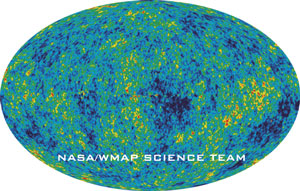
home | Who are we? | Workshop | Resources | Links | Gallery |
| Imaging the Universe - WMAP |
 This
picture shows how the universe looked 13 billion years ago! The millimetre
wave WMAP probe imaged the Cosmic Microwave Background: the radiant
heat left over from the Big Bang. This
picture shows how the universe looked 13 billion years ago! The millimetre
wave WMAP probe imaged the Cosmic Microwave Background: the radiant
heat left over from the Big Bang.
The temperature fluctuations in the image are tiny (0.0004°c!) but give cosmologists vital clues as to how matter in the early universe evolved to form the stars and galaxies that we see today. In molecular clouds such as Orion, the molecules radiate in the radio region when they spontaneously change rotational energy levels. Some molecules can be excited into higher states by the CMB and as they de-excite they give off light which can be in the millimetre region. This light can be observed from earth and used to deduce the chemical composition of the cloud. Observation in the millimetre region gives information about relatively heavy molecules. Planets are relatively bright objects at mm-wavelengths, which allow the search for new planets. A new telescope, the Atacama Large Millimetre Array (ALMA) is currently under construction in the Chilean Andes and when it is completed in 2012 it will have better resolution than the Hubble Space Telescope. It will be able to provide more detailed information about the CMB and the search for Earth-like planets in other solar systems.  |
'Vision For The Future' is an EPSRC funded project run by the MMW group at the University of St Andrews
Copyright ©2006 by the University of St Andrews :: web, graphic and exhibition design by FifeX Ltd, www.fifex.co.uk